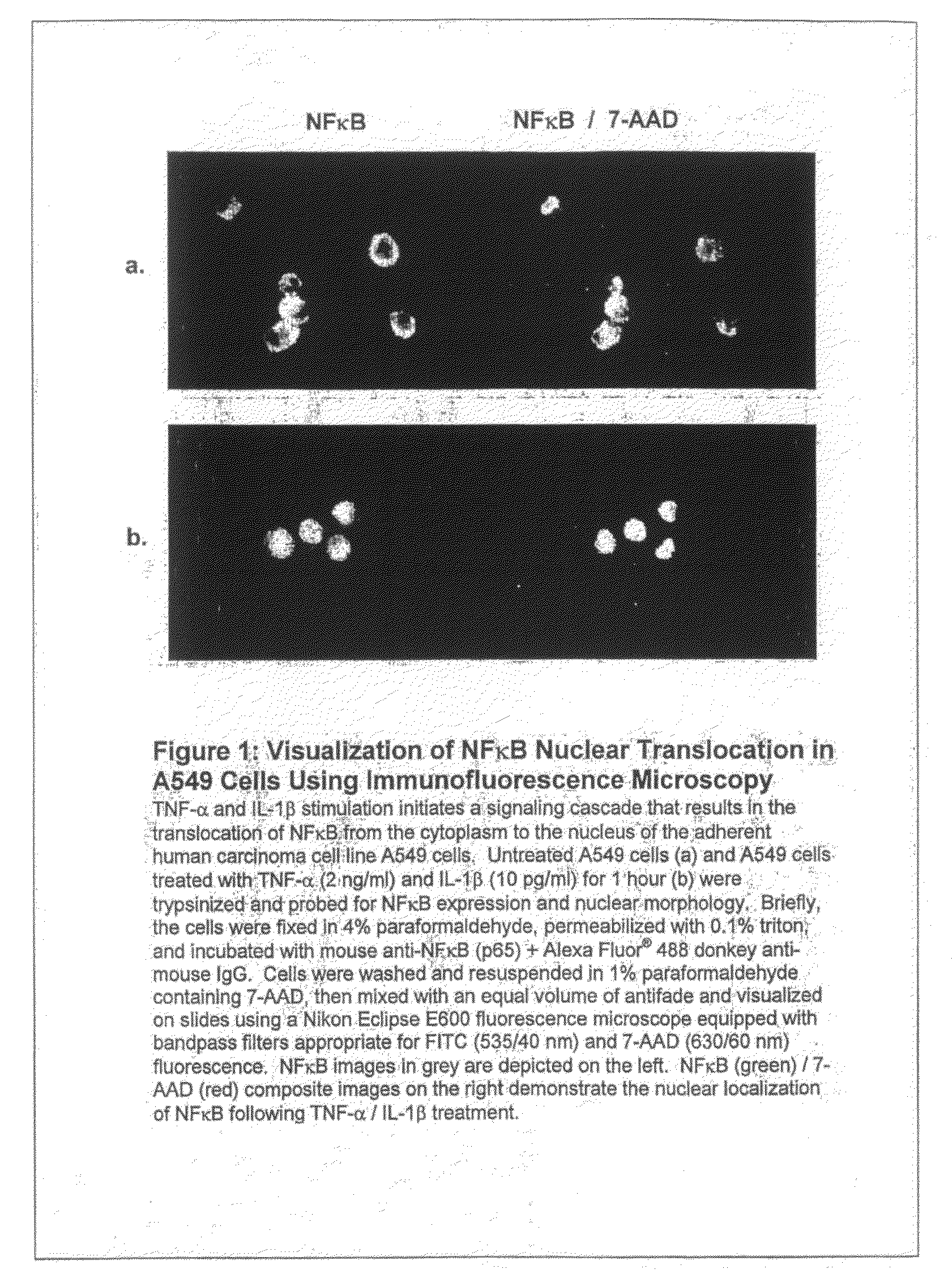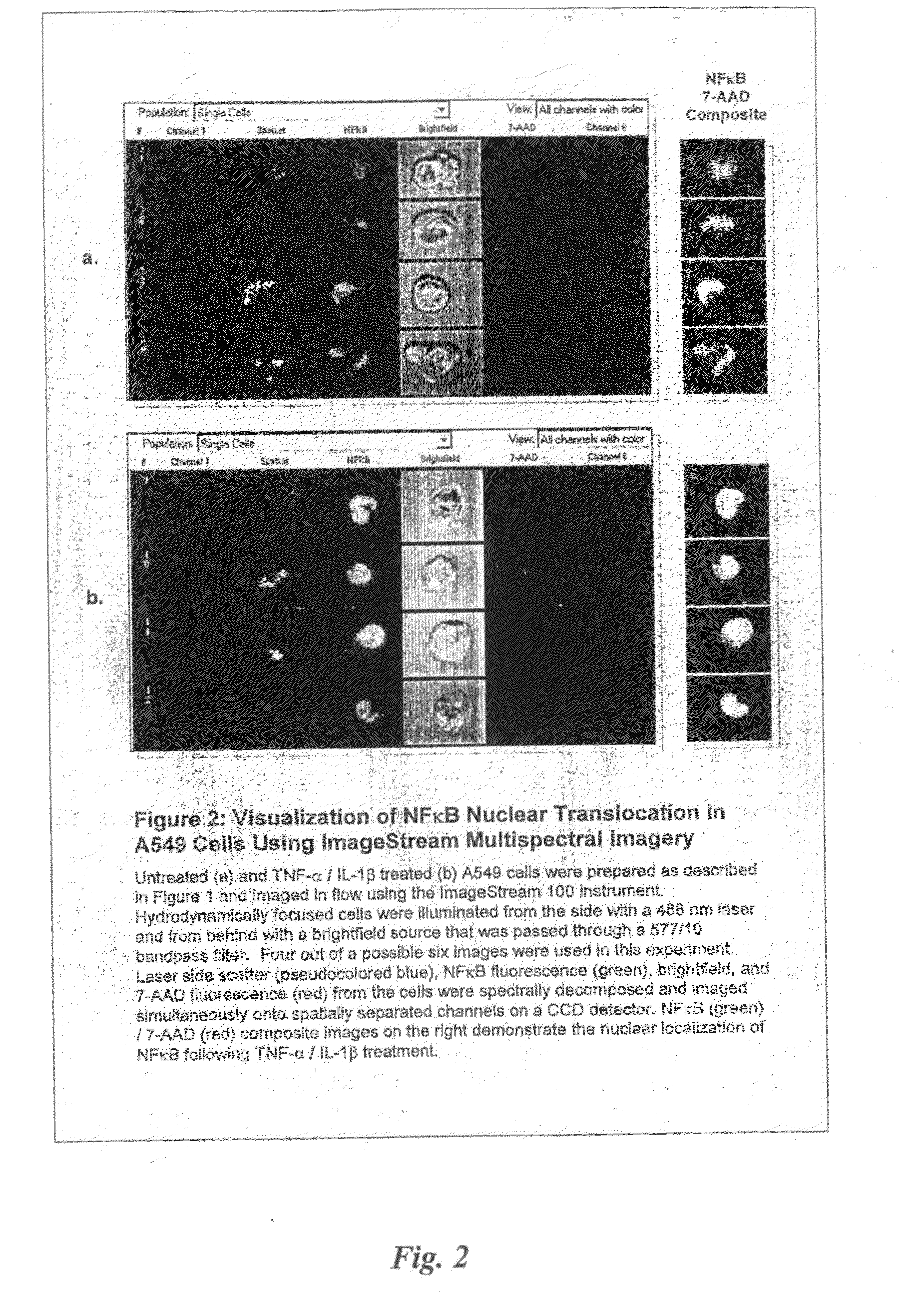Image based quantitation of molecular translocation
a molecular translocation and quantitation technology, applied in the field of molecular translocation quantitation based on image, can solve the problems of limited microscopic applications and the inability to produce the best measurement method
- Summary
- Abstract
- Description
- Claims
- Application Information
AI Technical Summary
Problems solved by technology
Method used
Image
Examples
example 1
Induction of Translocation in Adherent Cells
[0043]Human lung carcinoma cell line A-549, obtained from ATCC (Rockville, Md.), was maintained in RPMI 1640 (Gibco, Grand Island, N.Y.) containing 5% fetal bovine serum, 1 mM sodium pyruvate (Mediatech, Herndon, Va.), 100 μM nonessential amino acids, 100 U / ml penicillin, 100 μg / ml streptomycin, and 2 mM L-glutamine (BioWhittaker, Walkersville, Md.) in 5% CO2 atmosphere at 37° C. The density of exponentially growing cells was less than 3×105 cells per ml at the time of all treatments. To induce NF-κB translocation into the nucleus from the cytoplasm, cells were treated for 1 hr with IL-1β and TNF-α.
[0044]The following is the experimental procedure for TNF-α / IL-1β induced Nuclear Translocation of NF-κB in A-549 cells
Samples:
[0045]1) Unstained and single fluorescent color control samples—start with 3.0×106 total cells each. In this experiment, controls are:[0046]unstained[0047]NFκB Alexa Fluor488[0048]7-AAD
At the end, resuspend in 100 μl 0.1...
example 2
Induction of Translocation in Non-Adherent Cells
[0078]Human monocyte cell line THP-1, obtained from ATCC (Rockville, Md.), were maintained in RPMI 1640 (Gibco, Grand Island, N.Y.) containing 5% fetal bovine serum, 1 mM sodium pyruvate (Mediatech, Herndon, Va.), 100 μM nonessential amino acids, 100 U / ml penicillin, 100 μg / ml streptomycin, and 2 mM L-glutamine (BioWhittaker, Walkersville, Md.) in 5% CO2 atmosphere at 37° C. The density of exponentially growing cells was less than 3×105 cells per ml at the time of all treatments. To induce NF-κB translocation into the nucleus from the cytoplasm, cells were treated for 1 hr with LPS.
[0079]The following is the experimental procedure for LPS-induced Nuclear Translocation of NF-κB in THP-1 cells
Samples:
[0080]1) Unstained and single fluorescent color control samples—start with 3.0×106 total cells each. In this experiment, controls are:[0081]unstained[0082]NFκB Alexa Fluor488[0083]7-AAD
At the end, resuspend in 100 μl 0.1% triton X-100 / PBS.
[0...
example 3
Nuclear Staining and NF-κB Staining
[0108]Control (untreated) cell and LPS or IL-1β / TNF-α treated cells were independently counted and washed once in phosphate buffered saline (PBS, Fair Lawn, N.J.). Each cell group was resuspended at 107 cells / ml in 10 μM 7-aminoactinomycin D (7-AAD, Molecular Probes) for 10 minutes at room temperature. Cells were additionally stained with anti-NF-κB mAb-AF488 donkey anti-mouse IgG. Each cell group was washed, fixed in 2% paraformaldehyde (Sigma), and analyzed by flow cytometry and immunofluorescence microscopy.
PUM
| Property | Measurement | Unit |
|---|---|---|
| molecular movement | aaaaa | aaaaa |
| fluorescent | aaaaa | aaaaa |
| time delay | aaaaa | aaaaa |
Abstract
Description
Claims
Application Information
 Login to View More
Login to View More - R&D
- Intellectual Property
- Life Sciences
- Materials
- Tech Scout
- Unparalleled Data Quality
- Higher Quality Content
- 60% Fewer Hallucinations
Browse by: Latest US Patents, China's latest patents, Technical Efficacy Thesaurus, Application Domain, Technology Topic, Popular Technical Reports.
© 2025 PatSnap. All rights reserved.Legal|Privacy policy|Modern Slavery Act Transparency Statement|Sitemap|About US| Contact US: help@patsnap.com



